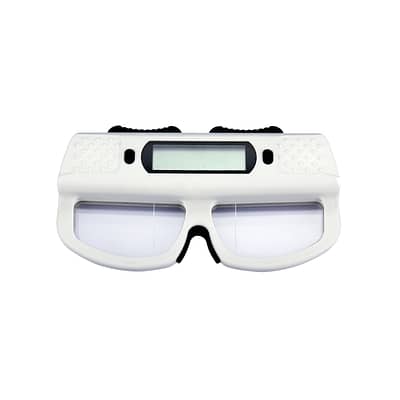What are the main devices for carrying out an eye exam?
The main devices used during an eye exam include:
- Automatic refractometer : This device automatically measures the refraction of the eye to determine the optical correction needed, including prescriptions for glasses or contact lenses.
- Phoropter : Also known as a “trial box”, this device is used to test different corrective lenses to determine the optimal optical correction for a patient.
- Keratometer : This device measures the curvature of the cornea to help diagnose conditions such as astigmatism and fit contact lenses.
- Slit lamp : This special lamp with a narrow slit is used to examine the internal and external structures of the eye, including the cornea, iris, lens and fundus of the eye.
- Ophthalmoscope : This device is used to examine the back of the eye, including the retina, optic nerve, and blood vessels, to detect conditions such as diabetic retinopathy, macular degeneration, and glaucoma.
- Tonometer : This device measures intraocular pressure to help diagnose glaucoma.
- Pupillometer : This device measures pupil size and responsiveness, which can help diagnose certain neurological and ophthalmic conditions.
These devices are used by optometrists and ophthalmologists during a comprehensive eye exam to assess eye health and determine the optical correction needed for each patient.
How to choose a device for eye exams?
The choice of a device for eye exams depends on several factors, including the type of practice (optometry or ophthalmology), patient volume, budget and the specific needs of the practitioner. Here are some tips for choosing a suitable device:
- Understand the needs of the practice : evaluate the specific needs of your practice in terms of the types of eye exams performed, the volume of patients and the services offered (routine exams, contact lenses, eye disease screening, etc.).
- Researching and Comparing Options : Conduct in-depth research on the different types of devices available in the market, including automatic refractometers, phoropters, keratometers, slit lamps, ophthalmoscopes, tonometers, etc. Compare features, performance, prices and user reviews for each device.
- Evaluate quality and reliability : opt for reputable brands and proven quality devices to ensure reliability and precision of results. Read reviews from eye health professionals and ask for recommendations from colleagues or industry experts.
- Compatibility and integration : Make sure the chosen device is compatible with other equipment and software used in your practice. Look for integrated solutions that enable seamless data transition and increased operational efficiency.
- Training and technical support : Make sure the supplier provides adequate training for you and your team on the use and maintenance of the device. Also look for a reputable provider that offers reliable technical support when needed.
- Budget and return on investment : Establish a realistic budget by considering the initial cost of the device as well as ongoing costs such as maintenance, upgrades and repairs. Evaluate the device's potential return on investment in terms of added value to your practice and patient satisfaction.
In summary, choosing a device for eye exams requires a thorough assessment of practice needs, careful research of available options, evaluation of quality and reliability, and consideration of budget and cost. return on investment. By following these tips, you will be able to choose a suitable device that meets the needs of your practice and provides accurate and reliable results for your patients.



